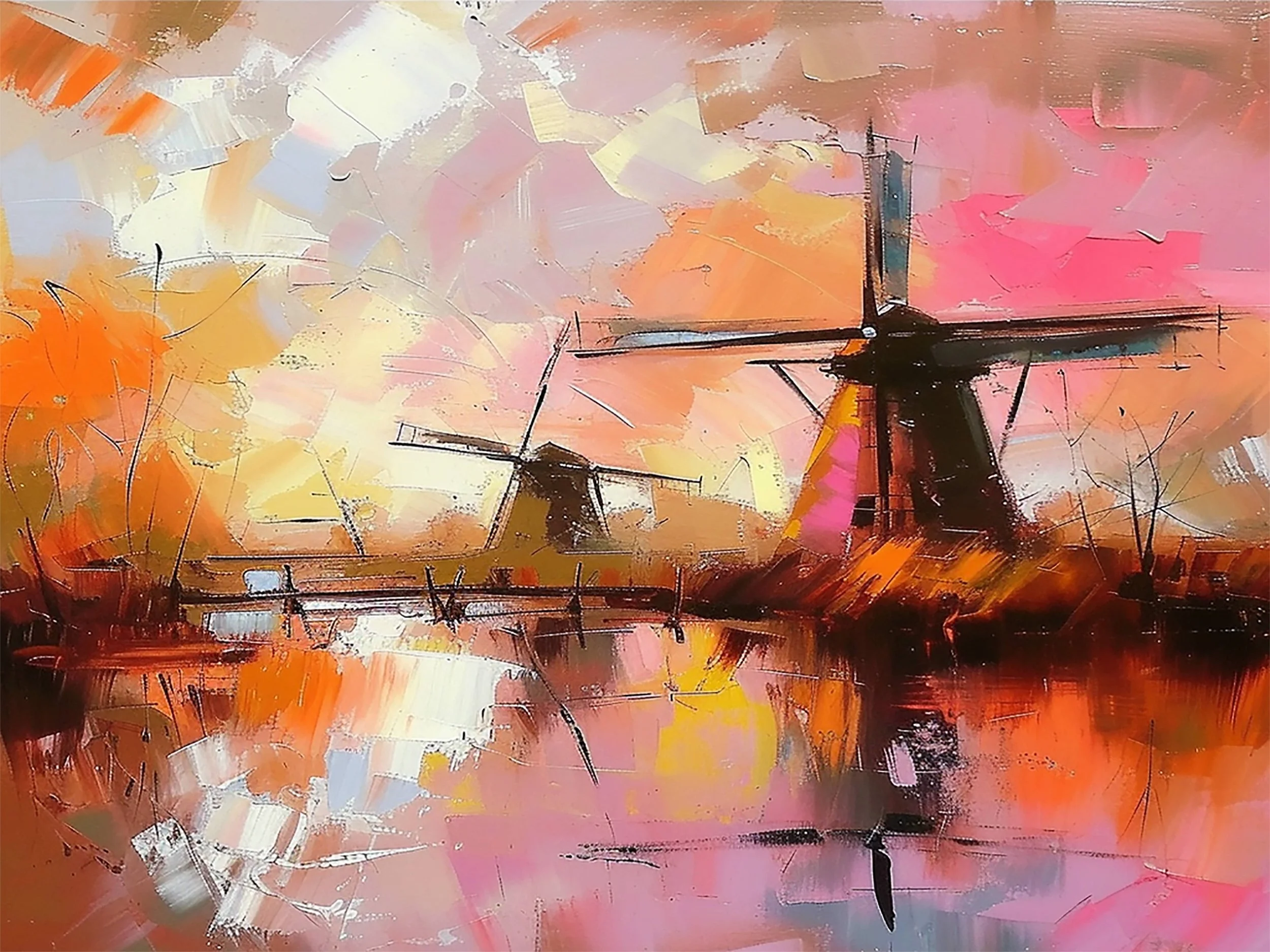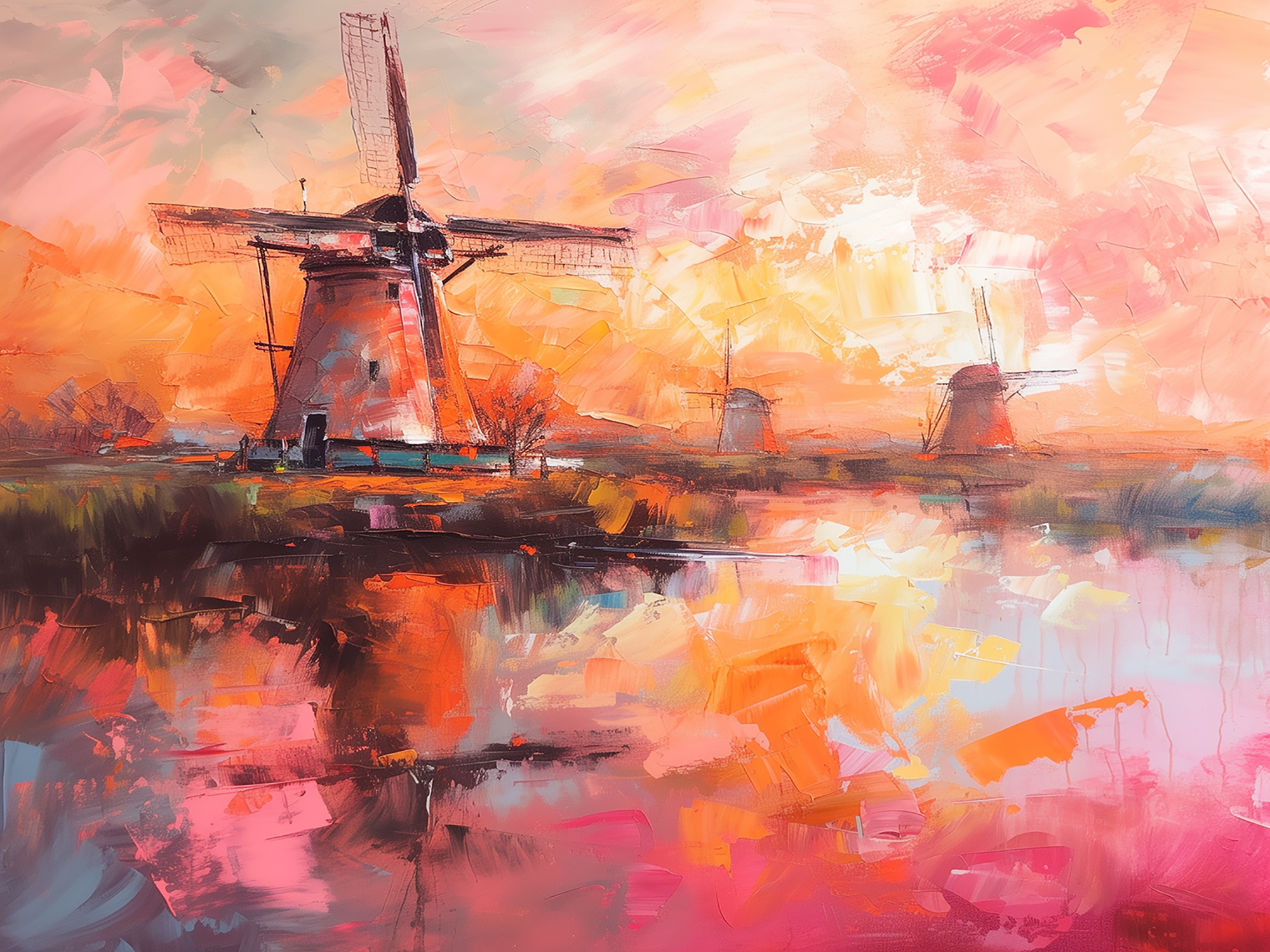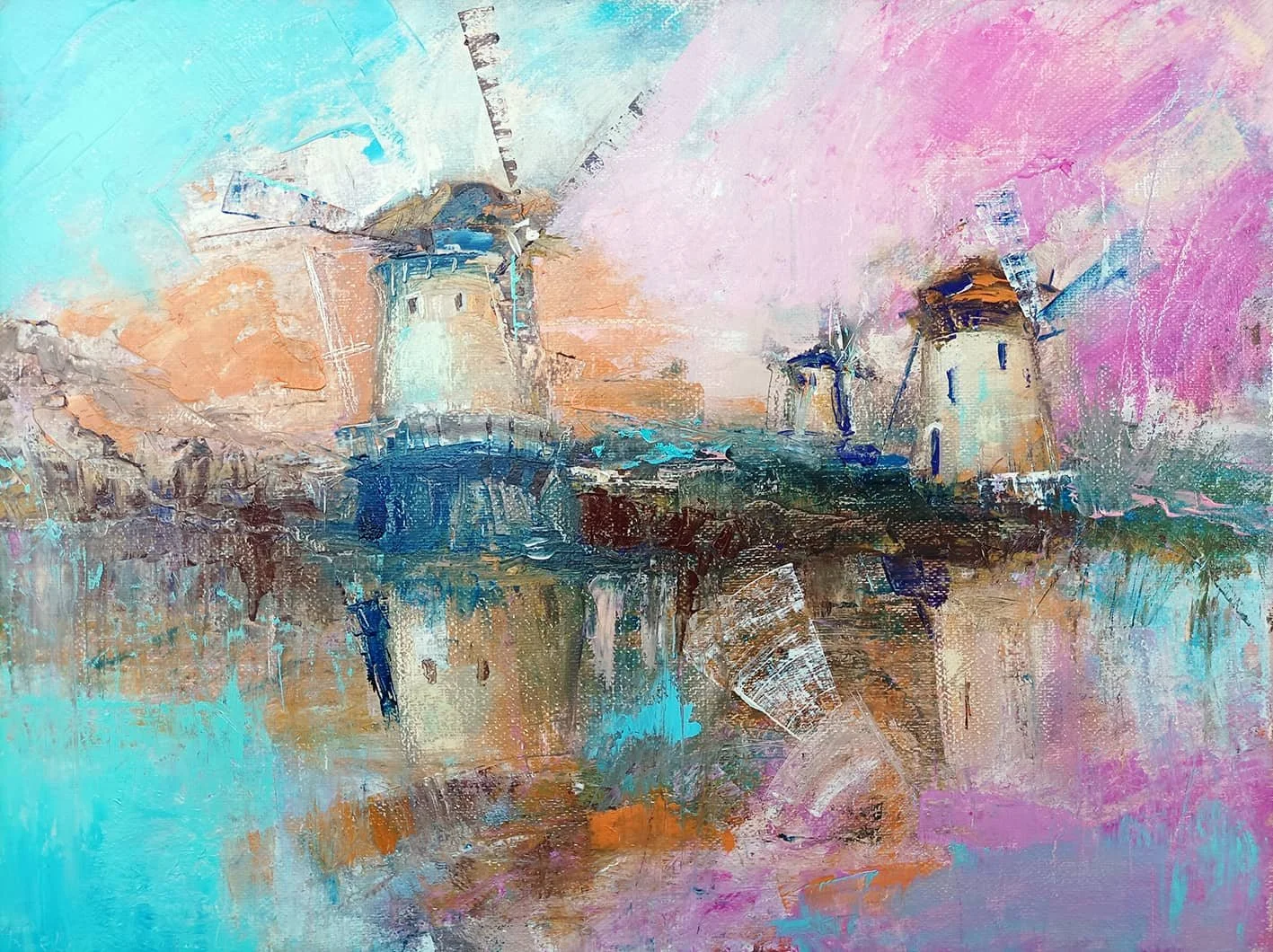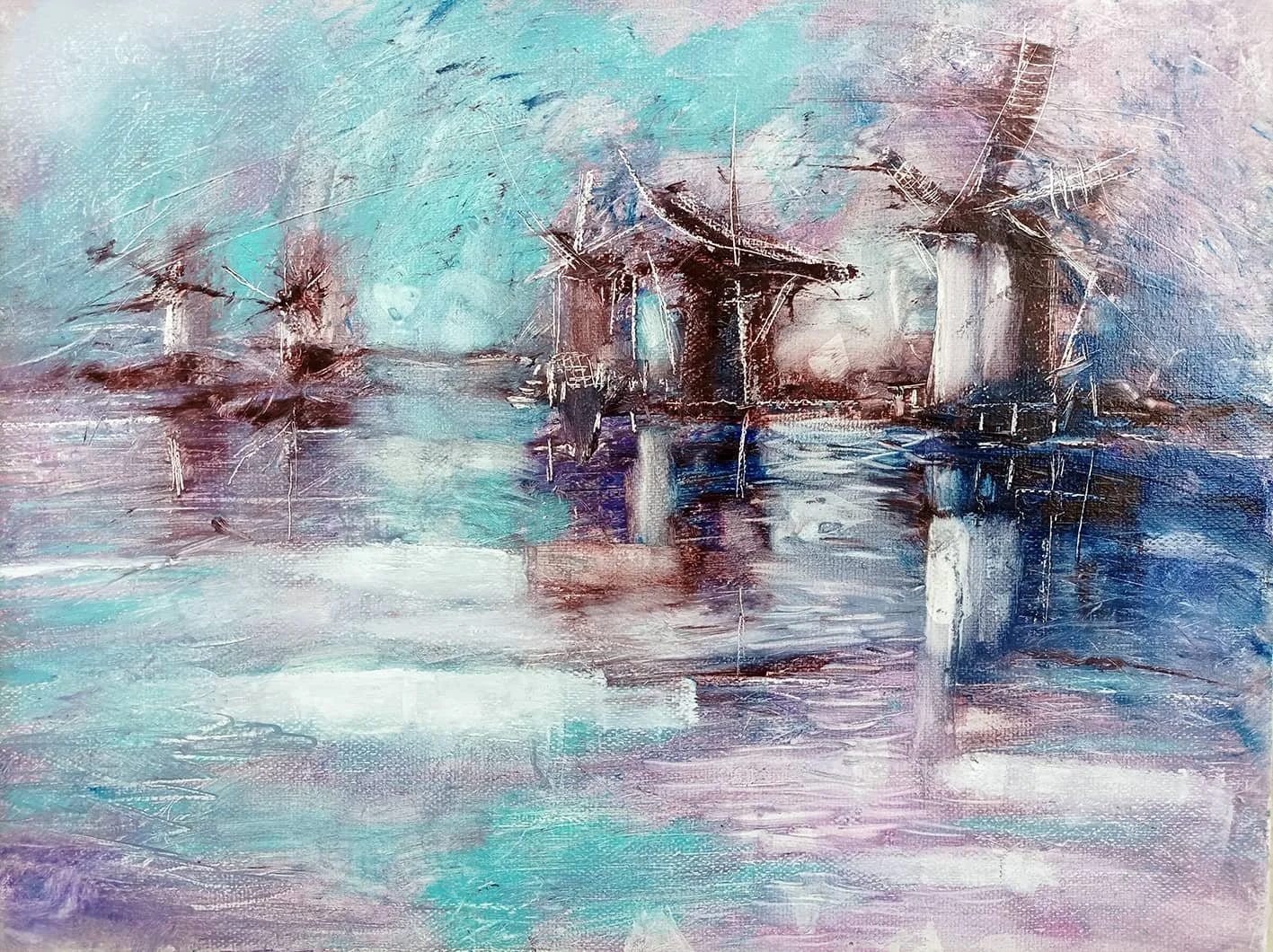Interview With Artist Kselma Randvald
Congratulations to Kselma Randvald for earning her place as a Winner in the Boynes Monthly Art Award November 2024 Edition!
Who are you?
I am an artist whose heart beats in harmony with the delicate beauty of nature and the intricate landscapes of the human soul. A dreamer, a romantic wanderer—I find myself forever traversing the labyrinth of my imagination, where colors bleed into one another and emotions run deeper than words. My world is painted in layers of nostalgia and curiosity. Each brushstroke I make is a whispered secret, each canvas a portal to another place. In my hands, brushes are not just tools but magic wands. They transform the mundane into something extraordinary, the forgotten into something cherished. Through my art, I attempt to capture fleeting moments, crystallizing them into something that feels both eternal and ethereal.
“Amsterdam Windmills at Dusk”
Oil
By Kselma Randvald
What inspired you to utilize painting as a medium?
Painting, for me, is an intimate language that transcends words. The fluidity of color, the dance of light and shadow, the way pigment settles on a canvas—these speak to me in a way no other medium can. There's a tactile poetry to painting: the softness of a brush gliding across linen, the deliberate scratch of a palette knife, the quiet patience of waiting for oil paints to dry.
I was drawn to this medium because of its boundless versatility and its ability to convey both delicate whispers and bold declarations. When I paint, I become part of a dialogue between my inner world and the canvas. It is a process of exploration, discovery, and, sometimes, revelation. Painting allows me to capture not only what I see but also what I feel and dream. It is my way of breathing life into the intangible, of giving form to fleeting visions.
How would you describe your ARTwork?
My artwork is an invitation—a gentle beckoning—to step into a world where time slows down. Where tranquility reigns. I strive to create a sense of nostalgia, a quiet ache for a beauty that perhaps existed, or perhaps never did. My pieces often revolve around serene landscapes where nature and humanity coexist in a delicate balance. A windmill silhouetted against the waning light, a child sledding through freshly fallen snow, or a sunset that burns just for a moment before surrendering to dusk.
I paint with a palette that favors soft, pastel hues—lavender skies, buttery yellows, muted sage greens—colors that breathe and glow. I let light play a pivotal role in my compositions, diffusing it across the canvas to create a warmth that can be felt, not just seen. My brushstrokes vary, sometimes barely a whisper, at other times a bold exclamation. Each work, I hope, resonates with a quiet yearning and offers a moment of stillness in an ever-rushing world.
Can you discuss the inspiration and thought process behind your winning work?
“Crimson Dreams. Windmills at Twilight” was born from a desire to capture the quiet poetry of a landscape in transition—from day to night, from reality to dream. I envisioned a dusky evening in the Dutch countryside, where the last light of the day melts into shades of amethyst and rose. Windmills, with their ancient and stoic forms, stand as sentinels over canals shimmering with fading reflections. They seemed to me like guardians of stories, keepers of history.
I was inspired by the Impressionists' ability to distill the play of light into pure emotion. Their brushwork, their fearless use of color, their ability to paint atmosphere rather than detail—all these influenced me. In “Crimson Dreams,” I wanted to create a scene that felt both tranquil and slightly melancholic. A place where the air is thick with memories, and the silence is alive with possibility. My goal was to evoke a timeless moment—where past and present, light and shadow, dream and reality blur into one.
“Whispers of the Windmill”
Oil
By Kselma Randvald
Can you walk us through the technical steps of creating your winning work?
The creation of “Crimson Dreams. Windmills at Twilight” began long before paint touched canvas. I immersed myself in studies—photographs, field sketches, and plein air sessions. I drew windmills over and over, capturing their essence in graphite before exploring their shapes in watercolor. This preparation gave me an intimate understanding of their structure, allowing me to move beyond the literal to the expressive.
Once my vision crystallized, I chose a smooth linen canvas, primed to hold the subtleties of layered oil paint. The underpainting was done in thin washes of burnt sienna and ultramarine to establish the values and mood. With a palette knife, I sculpted texture into the foreground—bold, almost reckless gestures—to contrast with the softness of the sky. Using a brush, I layered translucent glazes of violet, crimson, and cerulean, allowing each layer to breathe through the next.
I paid meticulous attention to the water, where reflections ripple and distort like fragmented memories. Highlights were added with the finest tip of a brush, delicate as a whisper. The final touches—softening edges, deepening shadows, brightening a glint of light—were like tying threads in a tapestry. A balance between control and surrender.
“Whispers of the Windmill”
Oil
By Kselma Randvald
What do you hope to communicate to an audience with your work?
I hope my artwork acts as a window—a view into a world where beauty is revered, where stillness is profound, and where nature's quiet strength is celebrated. I want viewers to feel a sense of peace, a deep exhalation, when they stand before my work. To be reminded that there is grace in simplicity, wonder in the overlooked, and solace in nature's embrace.
Through texture and color, I want to offer more than a scene; I want to offer a feeling. A reminder that art, like life, is about the subtleties. The way light bends, the way shadows whisper secrets. In a world full of noise, I hope my work can be a pause. A moment to reconnect—to the earth, to memory, to one's self.
Can you talk about your biggest learning experience during the process of creating your work?
The journey of creation is rarely a straight path. One of my most profound lessons came when I found myself trapped by my own need for perfection. While working on a large-scale piece, I felt paralyzed, each brushstroke scrutinized to the point of suffocation. Frustration tightened my grip.
I stepped away. Let time breathe between me and the canvas. When I returned, it was with fresh eyes—and I saw the heart of the problem. I had been obsessing over the minutiae, losing the soul of the composition. Letting go of the need for perfection, I rediscovered the joy of movement, of spontaneity. The canvas came alive again. I learned that sometimes, in surrendering control, we find the freedom to create our most honest work.
“Mill 1”
Oil
By Kselma Randvald
Can you discuss your biggest success since starting your artistic journey?
My biggest success isn’t defined by a single event or accolade but rather by a transformation—the moment when painting evolved from a hobby into a passion that sustains me. There was a point when I realized that my work was no longer just personal; it had begun to resonate with others. When someone tells me that my art has stirred a memory, soothed a worry, or sparked inspiration, I feel the immense power of connection. That is success.
Yet, beyond external validation, my triumph lies in the quiet perseverance of daily creation.
Each brushstroke, each experiment, each moment of doubt overcome is a victory. It is in embracing the journey, in knowing that my growth as an artist never truly stops. Each painting becomes a testament to that commitment, a milestone on a path that stretches endlessly ahead, shimmering with possibility.
Can you give us the best piece of advice you have ever heard/received?
The best advice I ever received was deceptively simple: “Embrace your mistakes.” As an artist, mistakes are inevitable, but they can also be transformative. This piece of wisdom unlocked a new level of freedom in my practice. Instead of fearing imperfections, I began to see them as opportunities. A misplaced stroke might become a dynamic texture; a color mixed wrong could reveal an unexpected harmony.
This advice taught me to loosen my grip, to allow spontaneity to have a say in my process. Sometimes, the richest discoveries come from these unplanned moments. When I stopped battling with my work and started collaborating with it, I found a deeper joy—and a deeper truth—in what I created.
As a winner, do you have any advice for artists who want to apply for awards, competitions, residencies, etc.?
Believe in the power of your unique voice. The art world is vast, and it can feel daunting to put your work out there, to subject your vulnerability to judgment. But remember: no one else can see the world through your eyes. Your perspective, your experiences, your imagination—they are your treasures.
When submitting to awards or residencies, don’t focus solely on the outcome. Instead, focus on the process. Let each submission be a celebration of your growth and a chance to refine your vision. Be bold. Be persistent. Understand that rejection is part of the journey, not the end of it. Keep showing up, keep creating. When you stay true to your voice, the world will notice.
“Mills 2”
Oil
By Kselma Randvald
What projects are you working on currently? Can you discuss them?
Right now, I’m venturing into new territory with a series inspired by the enigmatic beauty of outer space. This collection explores the depths of the color blue—from the inky blackness of the cosmos to the soft, velvety blues of twilight. My goal is to capture the ethereal balance of light and shadow, using layers of abstraction to evoke feelings of wonder and serenity.
Texture plays a significant role in these pieces. I’m experimenting with impasto techniques, building up the surface so that light dances across the raised forms. There’s an almost meditative quality to this exploration—a sense of gazing into the infinite and feeling, paradoxically, grounded. It’s a journey into the unknown, and I’m eager to see where it leads.
What is your dream project or piece that you hope to accomplish?
My dream project would be a large-scale public art installation—a piece that transcends the confines of canvas and invites interaction. I imagine a collaborative mural, something that blends diverse artistic voices and reflects the pulse of a community. A work that transforms an ordinary space into something extraordinary—a place where people pause, wonder, and feel connected.
I’d love for it to be tactile and dynamic, incorporating different materials and textures, playing with light and movement. Perhaps it shifts with the time of day or changes with the weather. The goal would be to create a living, breathing piece of art—one that sparks conversations, tells stories, and becomes a part of people’s daily lives.
Lastly, I like to ask everyone what advice they would give to their fellow artists, what is your advice?
My advice is simple yet profound: Take risks. Art thrives on bravery, on the willingness to step beyond what is comfortable or known. Don’t fear failure; embrace it as a teacher. Enter competitions, exhibit your work, collaborate with others—put your art into the world and let it breathe. Each risk you take feeds your growth.
Remember, the act of creation is its own reward. The joy is in the process—the way colors blend, the way ideas evolve, the way a blank canvas gradually transforms under your hands. Be authentic, be vulnerable, be relentless. If you do, the world will feel the pulse of your passion and respond.
To view more of Kselma Randvald




